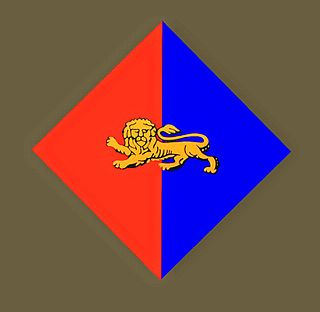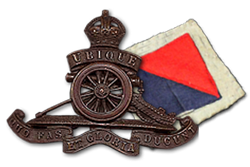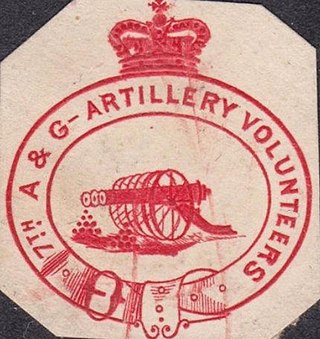
135th Field Regiment was a Royal Artillery (RA) unit being formed in Britain's part-time Territorial Army (TA) on the outbreak of World War II. Spun off from an existing unit, it took over two batteries from Hertfordshire and Northamptonshire and was later granted the double subtitle '(East Anglian) '. As part of the 18th Infantry Division the regiment remained in the United Kingdom until 1941 when it was sent to India. The division was deployed to Fortress Singapore where it was captured by the Japanese. Some of the prisoners were murdered in cold blood, many of the others died working on the Burma Railway. The regiment was never reformed.
The Birmingham Rifles was a volunteer unit of the British Army founded in Birmingham in 1859. As the 5th Battalion, Royal Warwickshire Regiment, it served as infantry on the Western Front and in Italy during World War I. Its successor units served in air defence during the early part of World War II, and later as anti-tank gunners in the Burma Campaign.

The 59th (Warwickshire) Searchlight Regiment, Royal Artillery was an air defence unit of the Territorial Army (TA), part of the British Army, and was raised in Birmingham in 1938 just before the Second World War. It later served as a light anti-aircraft gun unit and continued in the postwar TA.

The 56th Anti-Tank Regiment was a Territorial Army unit of the British Army's Royal Artillery (RA), which converted from the 4th Battalion, King's Own Royal Regiment (Lancaster). During the Second World War, it first served with the 42nd Division in the Battle of France and Dunkirk evacuation in May–June 1940. In 1942, it was sent to join the 70th Infantry Division in India, where it was converted into a Light Anti-Aircraft/Anti-Tank Regiment. In this guise, it served in the Burma Campaign, mainly with the 5th Indian Infantry Division. It reconverted to the anti-tank role in late 1944 and in June 1945 it returned to India as a training unit. It continued serving in the TA postwar until 1961, when it re-merged into the King's Own.

The 1st Lincolnshire Artillery Volunteers were formed in 1860 as a response to a French invasion threat. They fought on the Western Front during World War I. In World War II, the unit took part in the Battle of France and Dunkirk evacuation, the Anglo-Iraqi War with 'Kingcol', the Western Desert Campaign in which it distinguished itself at the Battle of Sidi Rezegh, and finally fought as infantry in the Chindits. The unit was disbanded in 1947.
The 2nd Kent Artillery Volunteers, later 4th London Brigade, Royal Field Artillery, popularly known as the Lewisham Gunners, was a volunteer unit of the British Army from 1860 until 1967. Initially raised in suburban West Kent, its recruiting area was later incorporated within the County of London. It provided two active service units in each of the World Wars, operating as far afield as Sicily, Burma and Madagascar, and later provided an airborne unit in the Territorial Army of the 1950s.

The 1st Devonshire Artillery Volunteers and its successor units served in the British Army's Reserve Forces from 1859 to 1961. During World War I it carried out garrison duty in British India but went on to see active service in the Third Anglo-Afghan War. Converting to an air defence role before World War II its units participated in the Norwegian campaign and the Dunkirk evacuation, the Battle of Britain and then the campaigns in North Africa, Italy, and Burma

The 1st Midlothian Artillery Volunteer Corps was formed in 1859 as a response to a French invasion threat. Originally it served as garrison and heavy artillery but transferred to the Territorial Force (TF) in 1908 as field artillery, in which role it served through both World Wars. In the First World War, it fought on the Western Front with 51st (Highland) Division. In the Second World War, it briefly saw service in France after the Dunkirk evacuation and later served with the Eighth Army in North Africa and Italy. Its wartime duplicate regiment served with distinction in the Burma campaign. Postwar, the regiment continued in existence until amalgamation in 1967.

The 2nd Cinque Ports Artillery Volunteers was a part-time unit of the British Army's Royal Artillery from 1890 to 1955. Raised as coastal defence artillery, it later served as field artillery in Mesopotamia during the First World War and in the Battle of France and Second Battle of El Alamein during the Second World War. Its successor units later operated as medium artillery in North West Europe, and as jungle artillery in Burma. Postwar, it became an anti-aircraft unit.

The 101st Heavy Anti-Aircraft Regiment, Royal Artillery was an air defence unit of Britain's Territorial Army raised in northern Scotland just before World War II. After defending the naval base of Scapa Flow against air attack in the early part of the war, the regiment went to India and later took part in the Burma Campaign in the anti-aircraft role and with heavy howitzers in support of ground forces, even on occasion fighting as infantry. It was reformed in the post-war TA and continued until the abolition of Anti-Aircraft Command in 1955.

The 1st Ayrshire and Galloway Artillery Volunteer Corps was formed in 1859 as a response to a French invasion threat. It transferred to the Territorial Force (TF) in 1908 and its successor units fought with the 52nd (Lowland) Infantry Division in Palestine during World War I, and in North West Europe and Burma during World War II. It continued in the Territorial Army (TA) until amalgamation in 1967.

The South Midland (Warwickshire) Royal Garrison Artillery was a volunteer artillery unit of Britain's Territorial Force formed in 1908. It served in Home Defence and provided heavy artillery support to the armies on the Western Front and Italian Front in World War I. In the interwar years it became 204 (Warwickshire) Battery serving in various regiments and formations before being expanded into a full regiment. In World War II it served in the heavy anti-aircraft (HAA) role defending its home area of the West Midlands against German air attack, and then defended Calcutta against Japanese attacks. It continued in the postwar Territorial Army until 1955.

The 115th Field Regiment was a part-time unit of Britain's Royal Artillery (RA), raised as part of the Territorial Army (TA) just before the outbreak of World War II. It served in the Battle of France and the Burma Campaign, and in the postwar TA.

130th (Lowland) Field Regiment was a Royal Artillery (RA) unit of Britain's part-time Territorial Army (TA) created just before World War II. It was formed from part of 79th (Lowland) Field Regiment, Royal Artillery, itself descended from the 1st Ayrshire and Galloway Artillery Volunteers, first raised in Scotland in 1859. After serving in home defence the new regiment was sent to India where it participated in the First and Second Arakan Offensives, and then in the Burma campaign (1944–1945). It was reformed in the postwar TA and continued in various roles until 1955.

The 5th Searchlight Regiment, Royal Artillery was a short-lived air defence unit of the British Army during World War II. Formed to defend Singapore in 1941, the regiment was captured less than a year later when the fortress surrendered to the Japanese.

The 51st Field Regiment, was a Royal Artillery unit of Britain's part-time Territorial Army (TA) formed after World War I from a Yeomanry Cavalry regiment recruited in Cumbria. One of its batteries served in the Norwegian campaign at the beginning of World War II. The regiment then sailed to the Middle East and took part in the Western Desert campaign, including the Siege of Tobruk and Operation Crusader. It was next transferred to Ceylon and later formed a Chindit column in the Burma Campaign. The regiment continued in the postwar TA until 1961.

52nd (Manchester) Field Regiment was a Royal Artillery (RA) unit of Britain's part-time Territorial Army (TA) during World War II. It was descended from the Manchester Artillery, first formed in the City of Manchester in 1860. It served in the Battle of France, at the end of which its personnel were evacuated from Dunkirk. It was then sent to the Middle East where it joined 8th Indian Division and fought with this division in the Italian Campaign. It was reformed in the postwar TA, and its successor unit continues as a battery in the present day Army Reserve

53rd (Bolton) Field Regiment was a Royal Artillery (RA) unit of Britain's part-time Territorial Army (TA) during World War II. It was descended from the Bolton Artillery, first formed in the Lancashire town of Bolton in 1889. It served in the Battle of France, at the end of which its personnel were evacuated from Dunkirk. It was then sent to the Middle East where it joined 8th Indian Division and fought with this division in the Italian Campaign. It was reformed in the postwar TA, and its successor unit continues as a battery in the present day Army Reserve

111th (Bolton) Field Regiment was a Royal Artillery (RA) unit of Britain's part-time Territorial Army (TA) formed just before World War II. It was descended from the Bolton Artillery, first formed in the Lancashire town of Bolton in 1889. After serving in home defence it was sent to the Middle East where it participated in the Second Battle of El Alamein and the Battle of Mareth. It served in the Italian Campaign, and was then transferred to Yugoslavia, fighting alongside Tito's Partisans. The regiment was disbanded at the end of the war.

The 180th Field Regiment was a unit of the Royal Artillery, formed by the British Army during World War II. First raised in 1940 as infantry of the North Staffordshire Regiment, it was converted to the field artillery role in 1942, serving as a reserve unit in Home Defence. It was disbanded before the end of the war.










